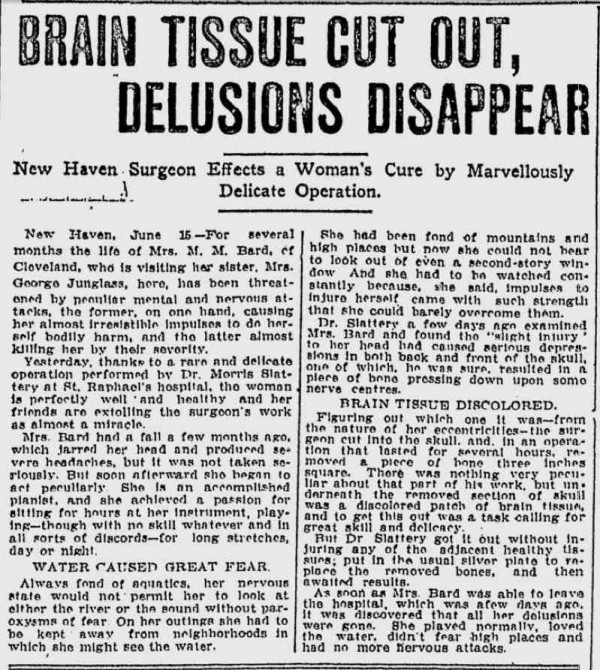Surgery
Frozen Sections of a Child
Back in 1881, Dr. Thomas Dwight of Harvard Medical School authored Frozen Sections of a Child, which sounds like the kind of book one might find in the library of a serial killer. As the title indicated, the book consisted of anatomical illustrations of frozen cross-sections of a three-year-old child.In the preface, Dwight helpfully included advice for those readers who might want to create their own frozen sections of a child:
More details: Harvard's Countway Library. You can also read the full book online via Google Books.

Posted By: Alex - Fri Feb 15, 2019 -
Comments (0)
Category: Body, Surgery, Books, Nineteenth Century
Circumcision training school
The Brith Milah School, established at New York’s Mount Sinai Hospital in 1968, was the world’s first-ever (and only?) school for circumcision training. It was a two-year program followed by a one-year internship. (Seems like a lot of training for a relatively simple operation. Though I guess it's important not to mess it up.)The first class graduated in 1970, but by the 1980s the school evidently no longer existed. According to a 1989 story on JTA (Jewish Telegraphic Agency) it “ran into problems when it could not get malpractice insurance for trainees who were not physicians.”

Wisconsin Jewish Chronicle - Mar 22, 1968

Wisconsin Jewish Chronicle - Dec 25, 1970
Posted By: Alex - Wed Nov 21, 2018 -
Comments (5)
Category: Body Modifications, Surgery, 1960s
Misunderstood Probability
I'm guessing the 50/50 chance didn't go in his favor.
Marion Star - Dec 28, 1995
Posted By: Alex - Fri Sep 01, 2017 -
Comments (7)
Category: Surgery, 1990s
The Anatomical Venus

This new book about the "Anatomical Venus" looks to be fascinatingly weird. Lots more photos at the link.
Posted By: Paul - Sat May 21, 2016 -
Comments (2)
Category: Art, Body, Surgery, Women, Eighteenth Century
Medical Reference Book
Handy in or out of the operating room.
Order Yours Here
Posted By: Expat47 - Wed Oct 22, 2014 -
Comments (5)
Category: Surgery, Books
Early Brain Surgery

[Click to enlarge]
Given the state of medical science in 1911, this purported good result seems like sheer luck!
Original article here.
Posted By: Paul - Sun Jul 20, 2014 -
Comments (5)
Category: Delusions, Fantasies and Other Tricks of the Imagination, Surgery, 1910s, Brain
Gastric Band Fails
A British TV special about failed gastric band surgeries that will air soon tells of some horrible ill effects people have suffered. One woman's band slipped causing part of her stomach to die. In addition to that fungus was growing on the band causing her to have a septic infection. As a result of the infection her stomach exploded. Wow, she really got her 8000 British pounds worth!
Posted By: Alex - Fri Oct 11, 2013 -
Comments (5)
Category: Surgery
Image of Corneal Transplant
The Encyclopedia of Surgery explains:the eye is held open with a speculum. A laser is used to make an initial cut in the existing cornea. The surgeon uses scissors to remove it, and a donor cornea is placed. It is stitched with very fine sutures.
Image via reddit.

Posted By: Alex - Tue Jul 31, 2012 -
Comments (10)
Category: Medicine, Surgery
How to anesthetize a hippo
Science Daily reports that progress has been made on the problem of how to anesthetize a hippopotamus:The solution involves "a new anesthetic protocol based on the use of two non-opiate drugs." This protocol was experimentally tested on 10 hippos, all of which "recovered rapidly and completely from the procedure and showed no lasting after-effects."
The interesting detail left out of the Science Daily article, but which can be found in the original article in the Journal of the American Veterinary Medical Association, is that all 10 hippos were castrated while asleep. If they had woken up while that was happening, I'm sure they really would have been angry!

Posted By: Alex - Mon Jul 09, 2012 -
Comments (4)
Category: Animals, Medicine, Surgery
Fingernail Surgery To Remove Seborrheic Keratoses
The medical rule I've heard is that you're not supposed to pick at zits or skin growths, because you'll only make them worse — or cause an infection. But apparently this rule doesn't apply to seborrheic keratoses. According to Dr. George Lundberg, Editor in Chief of MedGenMed, go ahead and pick 'em. Or rather, use "fingernail surgery" to remove 'em. That's what he does!However, Lundberg's advice hasn't met with universal approval from the medical community. Among the resonses to his editorial on MedGenMed is this one:
I find your piece embarrassing and unworthy of your Internet service.
If you had bothered to do some research, even just reading eMedicine, you would find that curettage, not excision, is the recommended treatment -- a far more sterile version of a fingernail surgery. The curettage procedure is usually nonscarring though rarely some mild hypopigmentation may result.
The use of fingernail surgery is to be condemned as it is a bacterially contaminated area.
Picking at one's own skin with the fingernails is a bad habit and in its extreme form can become obsessive and result in scarring -- a disorder known as neurotic excoriation.
Many elderly gentlemen will pick at solar keratoses on their scalp, leaving it in a persistent state of bleeding and infection; I sincerely hope that you are not headed in this direction.
If your medical colleagues excise your seb warts or cause significant scars, or if you suspect that they choose their therapies on the basis of cost benefit to themselves, I suggest you take the matter up with your State Medical Board rather than indulging in self-injury.
If there is any doubt about the diagnosis, the curetted specimen can be sent for pathology.
Cheers,
Philip Bekhor
Melbourne, Victoria, Australia
Posted By: Alex - Wed Mar 28, 2012 -
Comments (9)
Category: Health, Medicine, Surgery, Skin and Skin Conditions

| Who We Are |
|---|
| Alex Boese Alex is the creator and curator of the Museum of Hoaxes. He's also the author of various weird, non-fiction, science-themed books such as Elephants on Acid and Psychedelic Apes. Paul Di Filippo Paul has been paid to put weird ideas into fictional form for over thirty years, in his career as a noted science fiction writer. He has recently begun blogging on many curious topics with three fellow writers at The Inferior 4+1. Contact Us |




